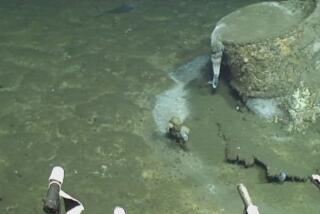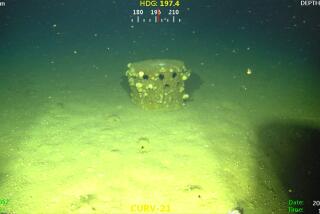Army Removed Tons of Explosives
- Share via
WASHINGTON — A U.S. Army demolition unit removed and destroyed up to 250 tons of explosives from an Iraqi storage complex shortly after the fall of Baghdad, but Pentagon officials were unable to say Friday whether the destroyed munitions were part of a cache of weaponry that U.N. inspectors said disappeared in the post-invasion chaos.
Pentagon officials offered a fragment of new and inconclusive evidence, but were unable to refute the most compelling suggestion that U.S. troops failed to safeguard the huge Al Qaqaa ammunition site.
A videotape taken by a Minnesota television station shows American soldiers breaking into sealed bunkers April 18, 2003, to find stacked crates of explosives.
The videotape appears to show soldiers using tools to cut through wire seals left by the International Atomic Energy Agency.
That bolstered reports by the interim Iraqi government and the United Nations nuclear inspectors that 377 tons of high-grade explosives were still at Al Qaqaa when the Iraq invasion began and were probably looted during the security breakdown that followed.
The munitions -- primarily powerful, high-grade material known HMX and RDX -- have become an issue in the race between President Bush and Democratic challenger Sen. John F. Kerry.
Kerry has charged that the disappearance of the weapons exemplifies failures by the president in handling the war.
He also has said it shows the administration failed to send in enough troops to secure Iraq and failed to heed warnings to secure the ammunition dumps.
Pentagon officials have sought to discredit these charges all week.
Secretary of Defense Donald H. Rumsfeld said in a radio interview Thursday that the weapons might have been removed by Saddam Hussein’s forces in the days before the U.S.-led invasion.
Pentagon officials Friday took a different tack, suggesting that large quantities of the explosives at Al Qaqaa were systematically removed and destroyed by U.S. forces after the war.
At a Pentagon news conference, Army Maj. Austin Pearson said his unit removed 200 to 250 tons of TNT, plastic explosives, detonation cords and white phosphorus rounds from the site April 13, several days after the fall of Baghdad to American troops.
But he could not say whether any of those munitions were among those inventoried by the IAEA.
“I did not see any IAEA seals at any of the locations we went into,” Pearson said. “I was not looking for that.”
Pentagon spokesman Lawrence Di Rita attempted to play down the significance of the missing weapons, pointing out that 377 tons amounts to less than “one-thousandth” of the 400,000 tons of Iraqi munitions U.S. troops have seized and destroyed since the war began.
A senior IAEA inspector who helped place the seals on the bunkers at Al Qaqaa said Friday that the site in the videotape appeared to be Al Qaqaa and that the seal snipped by soldiers trying to gain access to a weapons bunker seemed to be an authentic IAEA seal.
The agency’s chief Iraq inspector, Jacques Baute, said an explosives container imprinted with the Al Qaqaa label shown in the video also corresponded to his memory of the material the inspectors inventoried in January.
Baute was skeptical of media reports that the explosives might have been removed through ventilation slats in the bunker, leaving the seals and chains on the doors intact.
“If these vents had been fiddled with, we would be able to detect that -- even if they had been dismantled and put back with fresh concrete,” he said.
On Friday at the United Nations, Mohamed ElBaradei, the IAEA director-general, dismissed accusations that he timed the release of a letter reporting the disappearance of the explosives to influence the U.S. presidential election.
“It’s unfortunate that the whole thing has been hyped in the media,” he said. “There are other things happening in the world than the presidential election here.”
But he said that despite the hype, it remained a serious matter that the explosives might have fallen into the hands of insurgents, despite repeated warnings by the IAEA that the Al Qaqaa site should be secured.
“We need to focus on the message -- and the message is there is a serious issue on our hands -- and not to try to attack the messenger. That’s not the way to address the problem,” ElBaradei said.
“Our focus has been whether we can trace what happened to these explosives and try to recapture it,” he said. “Whoever is going to be [the new president] will still have some work to do.”
Mazzetti reported from Washington and Farley from the United Nations.
More to Read
Sign up for Essential California
The most important California stories and recommendations in your inbox every morning.
You may occasionally receive promotional content from the Los Angeles Times.










